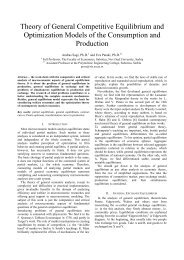Analysis and Design of a 1-DOF Leg for Walking Machines
Analysis and Design of a 1-DOF Leg for Walking Machines
Analysis and Design of a 1-DOF Leg for Walking Machines
Create successful ePaper yourself
Turn your PDF publications into a flip-book with our unique Google optimized e-Paper software.
<strong>and</strong> design <strong>of</strong> a leg, which is composed<br />
by a Chebyshev mechanism <strong>and</strong><br />
pantograph. Its main characteristic is<br />
to posses only 1-<strong>DOF</strong>, with many<br />
advantages in terms <strong>of</strong> cost <strong>and</strong><br />
operation.<br />
A leg design has been proposed to be<br />
low-cost <strong>and</strong> easy in operation <strong>and</strong> it<br />
has been also improved in its<br />
mechanical design by adding two<br />
articulated parallelograms that make<br />
the foot <strong>of</strong> the robot always parallel<br />
with respect to the ground.<br />
III A KINEMATIC ANALYSIS<br />
A Kinematic analysis has been carried<br />
out in order to evaluate <strong>and</strong> simulate<br />
per<strong>for</strong>mances <strong>and</strong> operations <strong>of</strong> the leg<br />
system. A fixed reference system CXY<br />
has been considered attached at point<br />
C, as shown in Fig. 1. The position <strong>of</strong><br />
point B with respect to CXY frame can<br />
be evaluated as a function <strong>of</strong> the input<br />
crank angle α <strong>and</strong> kinematic<br />
parameters <strong>of</strong> the Chebyshev<br />
mechanism LEBDC in the <strong>for</strong>m<br />
X B = – a + m cosα + (c+f) cosα<br />
Y B = – m sinα – (c+f) sinθ (1)<br />
in which<br />
2 2 2 1/2<br />
−1<br />
senα − (sen α + B − D )<br />
θ = 2tan<br />
B + D<br />
(2)<br />
Coefficients B <strong>and</strong> D can be obtained<br />
by considering the closure equation <strong>of</strong><br />
the five-bar linkage CDBGM in Fig. 1.<br />
Thus, one can obtain φ 2 <strong>and</strong> φ 3 angles<br />
in the <strong>for</strong>m<br />
⎛<br />
2 ⎞<br />
−1<br />
⎜ L1<br />
− 4L1L3<br />
⎟<br />
ϕ2<br />
= tan ⎜−<br />
L2<br />
−<br />
⎟<br />
2L1<br />
⎝<br />
⎠<br />
⎛<br />
2 ⎞<br />
−1<br />
⎜ K1<br />
− 4K1K3<br />
⎟<br />
ϕ3<br />
= tan ⎜−<br />
K2<br />
−<br />
⎟<br />
2K1<br />
⎝<br />
⎠ (3)<br />
where<br />
Figure 1<br />
A kinematic scheme <strong>for</strong> the 1-<strong>DOF</strong> leg<br />
L 1 = 2 X B z 2 – 2 X M z 2 + X 2 B + X 2 M +<br />
z 2 2 + Y 2 B + Y 2 M – z 2 3 – 2 X B X M –<br />
2 Y B Y M<br />
L 2 = – 4 Y B z 2 +4 Y M z 2 (4)<br />
L 3 = – 2 X B z 2 +2 X M z 2 + X 2 B + X 2 M +<br />
z 2 2 + Y 2 2<br />
B + Y M<br />
K 1 = – 2 X B z 3 +2 X M z 3 + X B 2 + X M 2 +<br />
z 3 2 + Y B 2 + Y M 2 – z 2 2 – 2 X B X M –<br />
2 Y B Y M<br />
K 2 = – 4 Y B z 3 +4 Y M z 3 (5)<br />
K 3 = 2 X B z 3 – 2 X M z 3 + X B 2 + X M 2 +<br />
z 3 2 + Y B 2 + Y M<br />
2<br />
Consequently, the transmission angles<br />
γ <strong>and</strong> γ 2 shown in Fig. 1 can be<br />
evaluated as γ =θ+φ 2 , <strong>and</strong> γ 2 =φ 2 +φ 3 .<br />
The position <strong>of</strong> A with respect to the<br />
fixed frame can be given as<br />
X A = X B – (z 2 +z 4 ) cosφ 2 + (z 3 +z 5 ) cosφ 3<br />
Y A = Y B – (z 2 +z 4 ) sinφ 2 – (z 3 +z 5 ) sinφ 3<br />
(6)












